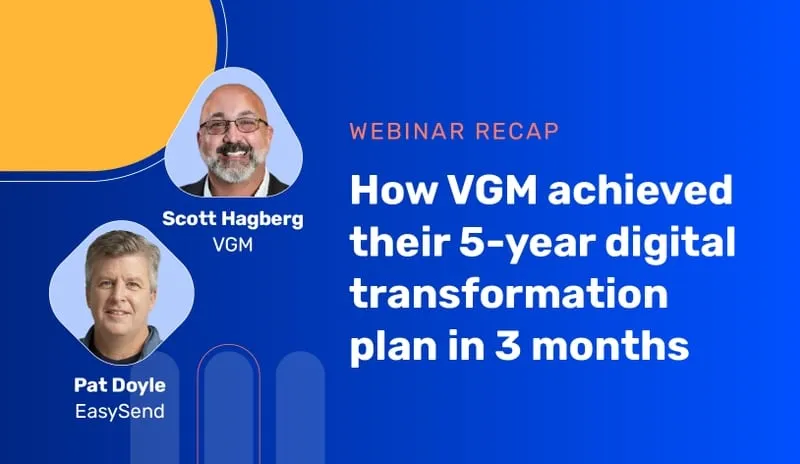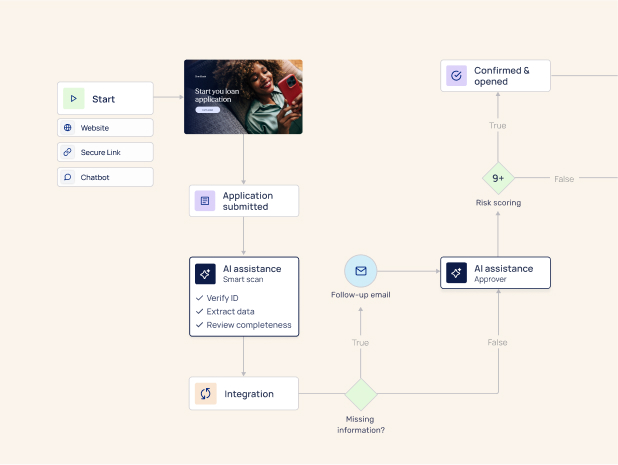Everyone has encountered those clunky PDF forms still dotted across many companies' websites. These forms must be downloaded, printed, signed, and scanned, or sent back via snail mail.
But none of that is necessary any longer with the digital customer journeys that provide a seamless, end-to-end process quick and seamless for your customers.
So why are so many companies still stuck in the past? Mainly because they are approaching digital transformation in the wrong way.
In our latest webinar, we were joined by Scott Hagberg, an award-winning application and automation architect at VGM insurance. We discussed how VGM achieved its 5-year digital transformation plan in 3 months, utilizing EasySend's platform as one of the driving forces behind that success.
With no-code and EasySend, we didn't have a steep learning curve, we didn't have to hire additional staff, and we could collect customer data and push it into our systems right away. We had it up and running in two weeks.
Here's a recap of what we covered:
- How VGM achieved its five-year plan in only three months
- A quick demo of EasySend
- Q&A session where we answered all your questions
If you missed the webinar, you can check out the replay here or keep reading this blog!
The five-year digital transformation plan
VGM Insurance provides unrivaled service industry expertise and specialty insurance coverage in a variety of niche industries, including post-acute healthcare, as well as golf and hospitality markets.
VGM was aiming for a digital transformation of their customer's touchpoints and internal processes. As the diagram below shows, the digital transformation roadmap included integrating their front-end and back-end systems, the middleware, and the API integration layer to bring data to their core systems. What they really wanted to do was digitize all incoming information to perform analytics and improve their business.

Digital transformation plan vs. the pandemic
The plan was accelerated when people started working from home due to the pandemic restrictions. With the PDFs, it was required to print the forms, fill them out, sign them and then, of course, scan that back in and submit it to the internal system. But there was a problem with that - many people didn’t have access to a printer in their homes. This approach became unsustainable with work from home, and customers demanded another option.
Transforming clunky PDFs processes
The VGM team started searching for a vendor who could solve the issue of digital customer data collection. After the selection process, they landed with EasySend, based on several criteria.
How do we get to market quickly?
"We wanted to be agile. We wanted to get these processes out to our customers as they were built. We didn't want to do a typical waterfall where we waited six to eight months to deliver everything at once. With no-code and EasySend, we didn't have a steep learning curve, we didn't have to hire additional staff, and we could collect customer data and push it into our systems right away. We had it up and running in two weeks."
What cost model would be beneficial for both parties?
"We didn't want to be held at ransom with a promise that something would be delivered at some point in the future. We didn't want to drop half a million dollars for a promise of something delivered in three months. With EasySend, after the initial setup cost, the price goes up on a pay-as-you-go basis. You are only charged when the process is live and after EasySend completes its work. This pricing model is mutually beneficial for both of us."
How will it impact the customer experience?
"The feedback was positive right away. We spoke with over 2000 of our renewal customers, who have been doing business with us for a while and knew the old way we did things. Their feedback was overwhelmingly positive, like, "Wow, this is quick! This is easy. I can do it from my mobile phone." They can sign the document, and as soon as they hit submit, we have all their data in our core system. We no longer have to wait for it to be scanned, and we don’t need to manually attach or detach the PDF from an email and then manually process it. As a result, we started seeing an uptick in our retention numbers. We started seeing an increase and feedback through our NSP. All of this is a clear indication that this was very well received by both the customers and our employees."
Buy vs. build decision
"We considered building these processes on our own. But as I mentioned, we're not digital application experts. So either you have to hire new talent or take that steep learning curve to get to market, learning as you go what it is to create a digital journey, connecting all the communications, setting the API integrations, etc. With EasySend, we got all this out of the box. Everything was built, the no-code platform allowed us to start going to market right away. As I previously mentioned, we were up in our environment two weeks after signing a contract with EasySend. So, that speed to market is where buying is a much better option than building it yourself.
The game-changer: full visibility into your customer data
With PDFs, you don't always get the answers to all your questions. Often, you would get applications with entire sections or fields missing that you require to move forward to underwriting, such as, for example, a missing signature. Because of that, the underwriting event could take up to a week or two simply because you have to keep going back and forth with the customer trying to get the required information.
All this is no longer a problem with digital journeys. We were able to digitize our data, removing the need to manually enter any data into our systems. The biggest advantage internally was that we could process these applications 100% complete with signature into our core system, which decreased the time it took to get to underwriting and go ahead and bind the policy.
We knew we wanted to do analytics, but one thing that was overlooked was how customers answered our questions and what changes could be made in order for us to receive better responses. This then helped us gain a complete view of customer data which ultimately allows us to make more informed decisions, improving customer experience along the way!
Boosting customer experience is always the biggest goal, but employee experience matters, too. With digital data collection, we no longer have employees manually entering anything into the system. That slashes our labor cost right off the top.
And then I guess the reporting and analytics improved dramatically. We are getting better data; we do not have to manually move it around from system to system; we don't need a data analyst to build Tableau reports and then try to understand them. Now we have everything in a digital format from the get-go to build out robust reports straight off the applications.
So to kind of summarize everything, we took this plunge into the digital world. As you can imagine, with any organization, we had hesitations, but going with EasySend really was the best decision that we made. It allowed us to get to market quickly, and we had a lot of success internally and externally with our customers.
Q&A
We ended the webinar with a few questions from the audience. Here are some of the highlights:
Q: What was the biggest advantage you saw? Were there any unexpected benefits that came about through this process?
A: The biggest advantage is the improved customer experience. But the large unexpected benefit was that we were able to digitize our data, completely removing the need to manually enter data. With PDFs, we would often get incomplete information, with sections, questions, or even signatures missing. So the biggest advantage was the ability to process these applications quickly, getting them 100% complete with signatures and all required fields into our core system without the need for any manual handling. This has significantly decreased the time required to go through underwriting and to go ahead and bind the policy.
Q: Can you talk a little bit about how you and your business users interacted with IT during the process?
A: I am from corporate IT, so from the get-go, I knew how important this collaboration is. One of the hard parts of working in IT is that you don't always have the complete picture of what the business needs and objectives truly are. So partnering with the business to understand their needs and requirements is a crucial prerequisite for success. Because we worked with a no-code platform, we could set up that digital process to match the original questions from the business side of things. It was actually a really well-formed relationship because we put people from both teams on the project team and overcame any obstacles we'd face.
Q: You referenced the decrease of 30 to 50% in operational costs. Can you talk specifically about areas where you saw the decrease?
A: Here, we are not talking about the overall operations. We're talking specifically about costs associated with receiving applications and policy sales. Because our data intake is completely digital, we no longer have employees manually entering any data into the system. That cuts labor costs significantly.
We also had systems in place that we used to generate the renewals, which we were able to retire, saving us costs of licensing and maintenance of these systems. Another huge savings was the time to complete the entire process. With a paper PDF, you don't always get all the answers you need, and because of that, the underwriting event could take up to a week or two simply because your team has to go back and forth with the customer, trying to get additional information. We were able to cut all of that down.
And then downstream in the process, we are also saving on reporting and analytics. We are getting better data. With digital data intake, we are able to build out robust reports straight off the applications without any additional effort.
Q: Can you talk about the out-of-the-box integrations that were available to you? How easy were they to set up?
A: It's quite easy to integrate with EasySend. You have a digital process, and then there you have what are called model items or objects that are populated with a JSON by calling the URL. The integrations were truly out-of-the-box. We just had to get a little bit of training on how to build and structure that JSON file. And we were able to call their URLs and make connections right away.
Q: What makes EasySend different from the other companies that are offering similar services?
A: EasySend is not just another vendor. This was a true partnership andthe process was very collaborative. Their team’s approach is very agile. Right away, they broke down the project into smaller digestible pieces so that we could get value right away. Another difference is the cost model that doesn’t hold us at ransom with the promise of getting there someday. With EasySend, you first build your process, get value immediately, and then pay for it. And it works perfectly for us.





